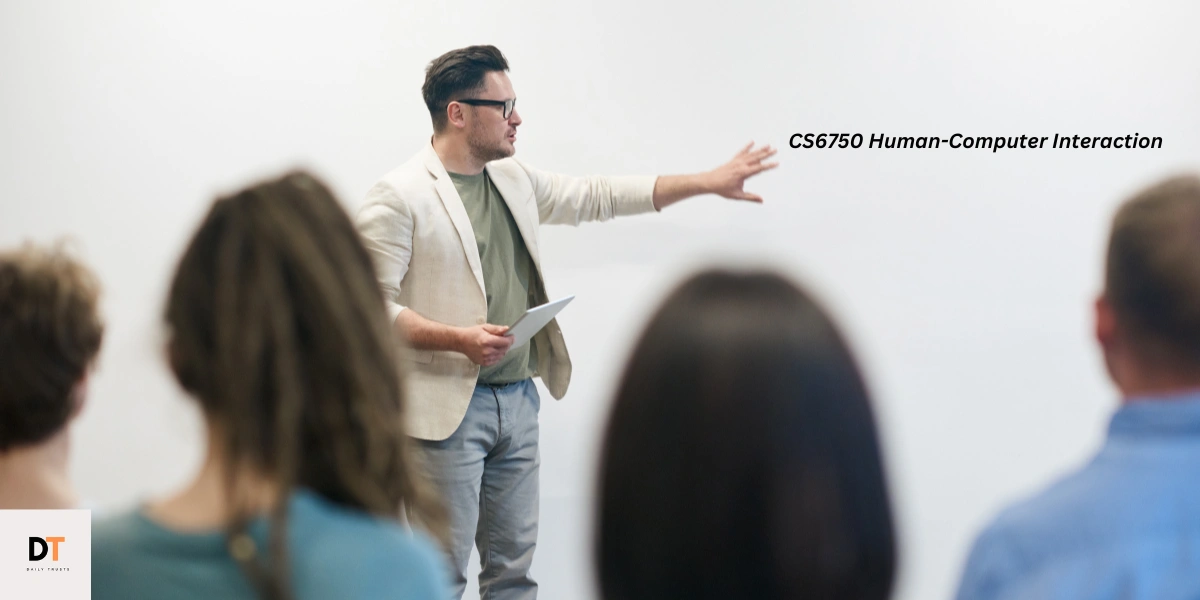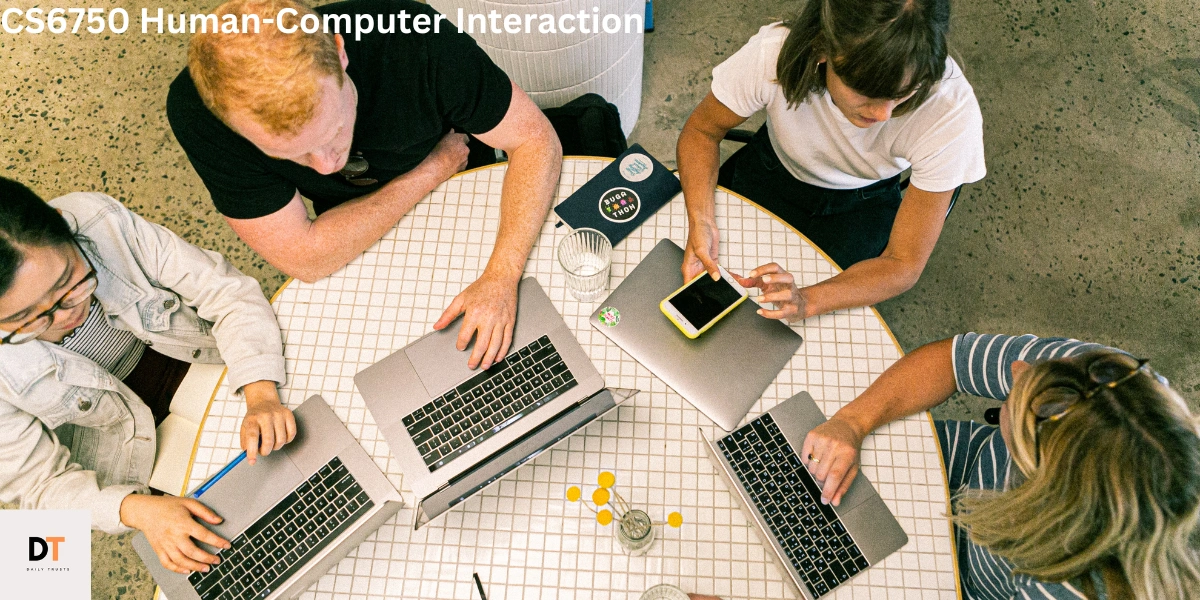OMSCS CS6750 (Human Computer Interaction) Review and Tips
Human-Computer Interaction (HCI) is a rapidly growing field that focuses on the design, evaluation, and implementation of interactive systems to improve the relationship between humans and computers. CS6750, a course dedicated to HCI, is an opportunity to delve deeply into this exciting domain. The course explores the principles of user-centered design and equips students with the skills to create intuitive, efficient, and accessible technological solutions. As technology continues to permeate every aspect of our lives, HCI becomes increasingly vital, influencing how we interact with devices, software, and systems.
In this article, we will take a comprehensive look at CS6750, outlining its objectives, core topics, practical applications, and relevance to career growth. By understanding the scope of HCI, students and professionals alike can appreciate its significance in shaping technology that caters to human needs.
Also Read:
Commercial Ovens for Baking Cakes
What Is CS 6750?
Human-Computer Interaction, the subject of CS 6750, examines how people utilize technology and how to create systems that are simple, effective, and easy to use. The course explores usability concepts, the theoretical foundations of HCI, and useful techniques for interface design and evaluation.
This course is ideal for anyone interested in:
- Enhancing hardware and software systems’ usability.
- Putting the user experience (UX) first while designing interfaces.
- Understanding user behavior and cognitive psychology in relation to technology.
Why take this course?

I create machine learning systems and APIs for internal and external users as part of my daily work. Adoption isn’t always as easy or straightforward as I had thought, so I wanted to get better at designing products and interfaces to help reduce adoption barriers. Better knowledge of product and interface design techniques, a framework for asking pertinent questions of users, and procedures for rapidly iterating and improving design are all part of this.
I’ve previously taken classes taught by Professor David. I learned a lot about how to scale and make education more accessible, and it was a lot of fun. Education Technology was also really well run. This led to the creation of a MOOC on Effective Data Science. Therefore, choosing to enroll in another course offered by Professor David was simple.
I also wanted to work on my writing abilities more. The majority of the writing at work and in my most recent coursework has been code. I therefore desired a chance (as well as the setting) to challenge myself to produce more content and substance.
Course Structure and Format
The format of CS 6750 consists of lectures, homework, and group projects. Usually, it goes like this:
- Lecture Videos
Georgia Tech academic members provide the course material in pre-recorded videos, frequently accompanied by slideshows and supplementary readings. The goal of these brief, orderly movies is to provide viewers with a fundamental understanding of HCI concepts. - Assignments
The purpose of assignments is to strengthen the ideas covered in lectures. They range from brief questions to in-depth user interface criticisms. - Projects
The team project, which is the focal point of CS 6750, requires students to work together to examine a real-world issue and suggest an HCI-driven solution. This multi-stage project consists of:- Problem Identification: The problem space is defined.
- User Research: Doing out research to comprehend the intended audience.
- Prototyping: Making a prototype, either high- or low-fidelity.
- Evaluation: Design testing and iteration in response to input.
- Exams
Instead of focusing on rote memory, exams aim to assess conceptual knowledge. They include of short-answer and multiple-choice questions drawn from readings, case studies, and lectures.
Key Topics Covered of CS6750 Human-Computer Interaction
Because it covers a wide range of subjects, CS 6750 is appropriate for a wide range of learners:
- Foundations of HCI: being aware of interaction models, usability, and user-centered design.
- Cognitive Psychology in HCI: investigating human perception, memory, and information processing.
- Design Principles: gaining knowledge of the layout, color, typography, and interaction strategies that make up a good interface.
- User Research Methods: carrying out usability testing, interviews, and surveys.
- Prototyping Tools and Techniques: Use paper prototypes or software like as Figma or Sketch.
- Ethics in HCI: addressing inclusion and accessibility in the design of technology.
Core Topics Covered by CS6750 Human-Computer Interaction

The curriculum of CS6750 encompasses a wide range of topics, each contributing to a comprehensive understanding of HCI. Here are the key areas of focus:
1. Human-Centered Design
Human-centered design is the cornerstone of HCI. This topic covers:
- Understanding Users: Identifying user needs, preferences, and limitations through research methods such as interviews, surveys, and observational studies.
- Iterative Design Process: Prototyping, testing, and refining designs based on user feedback.
- Design Thinking: Employing creative problem-solving techniques to generate innovative solutions.
2. Cognitive Psychology in HCI
HCI relies heavily on insights from cognitive psychology to design interfaces that align with human behavior. Key concepts include:
- Perception and Attention: Designing interfaces that effectively capture and maintain users’ attention.
- Memory and Learning: Ensuring designs are intuitive and reduce cognitive load.
- Decision-Making: Creating systems that guide users toward desired actions without overwhelming them.
3. Interaction Design
Interaction design focuses on the methods and techniques users employ to interact with technology. This includes:
- Input Methods: Exploring touch, voice, gesture, and other input techniques.
- Design Patterns: Understanding common interface elements such as navigation bars, buttons, and menus.
- Feedback Mechanisms: Providing users with immediate and meaningful responses to their actions.
4. Prototyping and Evaluation
Prototyping and evaluation are essential for refining designs. Students learn:
- Prototyping Tools: Using software like Figma, Adobe XD, and Sketch to create interactive prototypes.
- Usability Testing: Conducting tests with real users to identify strengths and weaknesses in designs.
- Metrics and Analysis: Measuring usability through metrics such as task completion time, error rates, and user satisfaction.
5. Accessibility and Inclusivity in Design
Inclusive design ensures that technology is usable by people with diverse abilities and backgrounds. Topics include:
- Designing for Disabilities: Implementing features such as screen readers, voice commands, and high-contrast modes.
- Cultural Sensitivity: Adapting interfaces to suit different languages, cultures, and social contexts.
- Legal and Ethical Considerations: Understanding accessibility laws such as the Americans with Disabilities Act (ADA) and WCAG guidelines.
6. Emerging Technologies in HCI
The field of HCI constantly evolves with technological advancements. Emerging topics include:
- Augmented Reality (AR) and Virtual Reality (VR): Designing immersive experiences for gaming, education, and training.
- Artificial Intelligence (AI): Creating conversational interfaces, chatbots, and recommendation systems.
- Wearable Technology: Exploring interfaces for smartwatches, fitness trackers, and healthcare devices.
Project and Practical Applications

One of the highlights of CS6750 is its emphasis on practical applications. Students participate in hands-on projects that allow them to apply theoretical knowledge to real-world problems. These projects typically involve:
- Case Studies: Analyzing successful and unsuccessful designs to understand best practices and common pitfalls.
- Group Collaboration: Working in teams to tackle complex design challenges and learn from diverse perspectives.
- Prototyping and Testing: Using industry-standard tools to create and refine interactive prototypes.
For example, students may be tasked with designing a mobile app for elderly users or a website for a non-profit organization, emphasizing accessibility and usability.
Career Opportunities in HCI
HCI is a multidisciplinary field with a wide range of career opportunities. Professionals trained in HCI can pursue roles such as:
- UX Designer: Specializing in creating user-friendly interfaces and enhancing user satisfaction.
- Human Factors Specialist: Focusing on optimizing the interaction between humans and systems in industries like healthcare, aviation, and automotive.
- Interaction Designer: Designing intuitive and efficient user interactions for web and mobile applications.
- Usability Analyst: Conducting research and testing to improve the usability of products and systems.
HCI professionals are in high demand across industries such as technology, healthcare, education, and entertainment. The skills acquired in CS6750 provide a strong foundation for success in these roles.
Why should you consider HCI?
In our daily lives, we come into contact with so many devices and computers that we even forget what life would be like without them. If you have forgotten that a computer is used in some aspect of your life to do some of your tasks, it is evidence of how user-friendly the device is, which is made possible by the effective application of HCI principles. In a similar vein, you may also have a good number of poorly designed HCI elements that are inconvenient to use and don’t work.
There are interfaces everywhere, and it’s likely that the job you do has an impact on an interface that many people use. Learning about HCI will expose you to a fantastic foundation for tackling these kinds of issues. It will show you how design may have a bigger impact on society and what makes an interface more suited for human users. As I worked on the topic of enhancing the developer experience throughout the organization, I was able to apply this framework at work, therefore it was a terrific learning experience for me.
What is included in this course?

This course is designed to provide a comprehensive learning experience, covering all essential aspects of the subject. Here’s what you can expect:
- Detailed Lessons: Step-by-step tutorials that simplify complex concepts.
- Practical Exercises: Hands-on tasks to strengthen your skills.
- Downloadable Resources: Access to e-books, templates, or guides for offline study.
- Interactive Quizzes: Test your understanding and track your progress.
- Expert Support: Guidance from professionals to address your queries.
- Certificate of Completion: A recognized certificate to showcase your achievement.
Whether you’re a beginner or looking to advance your knowledge, this course includes everything you need to succeed!
Key Takeaways from CS6750
CS6750 equips students with both theoretical knowledge and practical skills. Key takeaways include:
- User-Centered Approach: Understanding the importance of prioritizing user needs in design.
- Practical Skills: Gaining proficiency in tools and techniques for prototyping, testing, and evaluation.
- Ethical Awareness: Recognizing the societal and ethical implications of design decisions.
These skills enable students to create technology that enhances user experiences and improves the quality of life.
What Makes CS 6750 Unique?
- Interdisciplinary Approach: HCI lies at the nexus of design, psychology, and technology. The focus of the course is on how improved designs might result from an understanding of user behavior and cognitive limits.
- Practical Application: One of the course’s best features is the practical project. In addition to learning HCI ideas, students also apply them to actual issues. Anyone hoping to work in product design or user experience would find this knowledge beneficial.
- Collaborative Learning: The group project encourages cooperation, dialogue, and the sharing of different viewpoints. In today’s tech industries, these soft skills are just as important as technical knowledge.
Challenges of CS 6750
Although profitable, there are some difficulties with CS 6750:
- Time Management: The course requires a substantial time investment. In particular, the team project calls for steady work over a number of weeks. Students frequently have to balance additional schoolwork, group meetings, and individual homework.
- Group Dynamics: Working together can have both benefits and drawbacks. Communication styles and degrees of commitment vary when working in a team. Clear role distribution and efficient collaboration are frequently essential for successful organizations.
- Abstract Concepts: In contrast to courses that heavily emphasize programming, some students with strictly technical backgrounds may find the emphasis on psychology and design principles to be abstract or less understandable.
- Prototyping Skills: The prototyping stage can be intimidating if you are not experienced with design tools. Nonetheless, a wealth of resources are available, and peers are typically eager to assist.
CS6750: Human-Computer Interaction 2022
Human-Computer Interaction (HCI) is an essential area of study within the realm of computer science, focusing on the interaction between users and technology. CS6750, offered by Georgia Tech as part of the Online Master of Science in Computer Science (OMSCS) program, is a popular course that dives deep into this field. This article provides an overview of the course content, available resources, and the broader discussions surrounding it.
CS6750 Human-Computer Interaction Answers
One of the key challenges for students taking CS6750 is navigating the assignments and assessments. The course emphasizes applied learning, requiring students to analyze user interfaces, conduct usability studies, and propose design improvements. While sharing direct answers to assignments is against academic integrity, collaborative learning and conceptual discussions on forums like Reddit and Slack channels are encouraged.
Students often rely on the extensive course materials, including lectures and readings, to solve problems. For example, questions about usability heuristics, cognitive load, and interaction design principles are tackled by revisiting course content and applying critical thinking.
To excel in the course, students are advised to:
- Thoroughly review the provided course materials.
- Engage in peer discussions without violating academic policies.
- Practice by applying HCI principles to real-world interfaces.
CS6750 Notes
Keeping comprehensive notes is vital for success in CS6750. The course covers various topics, such as:
- Usability heuristics (e.g., Nielsen’s 10 heuristics).
- Cognitive and physical ergonomics.
- Prototyping methods.
- Evaluating user interfaces using metrics like SUS (System Usability Scale).
- Inclusive and accessible design.
Students often share summarized notes in online communities, which serve as a great resource. Creating personalized notes by summarizing lectures and readings can also help solidify understanding. A consistent focus on real-world application and case studies ensures these notes remain useful beyond the course.
CS6750 Human-Computer Interaction Reddit
Reddit has become a valuable platform for students and professionals alike to discuss courses like CS6750. Subreddits such as r/OMSCS and r/hci are buzzing with discussions about:
- Tips for acing the course.
- Experiences with professors and teaching assistants.
- Resources like recorded lectures, book recommendations, and cheat sheets.
Many students use Reddit to share their experiences and ask for advice. However, it’s important to be cautious about sharing or consuming content that could violate academic integrity guidelines. The platform’s strength lies in fostering a sense of community and support.
OMSCS Specializations
The OMSCS program offers various specializations, and HCI is a crucial component of the “Interactive Intelligence” track. Specializations include:
- Interactive Intelligence: Focuses on HCI, artificial intelligence, and machine learning.
- Computing Systems: Covers system design, networking, and security.
- Machine Learning: Centers on data analysis, algorithms, and AI applications.
- Robotics and Perception: Explores robotics systems and sensor integration.
Students in the Interactive Intelligence specialization often find CS6750 to be a cornerstone course, bridging theoretical concepts with practical applications.
OMSCS Interactive Intelligence
The Interactive Intelligence track emphasizes creating systems that seamlessly interact with humans. CS6750 lays the foundation by equipping students with skills to design user-centric interfaces, conduct usability tests, and understand human factors in computing. Paired with courses like Machine Learning and AI for Robotics, this specialization prepares students for careers in UX design, usability engineering, and intelligent system design.
Who Should Take CS 6750?
- Aspiring UX/UI Designers: This course provides foundational skills for a career in UX or UI design.
- Product Managers: Understanding HCI is crucial for PMs who oversee product development and interface design.
- Software Engineers: Engineers looking to enhance their ability to create user-friendly applications will benefit greatly.
- HCI Researchers: The course offers a primer for those interested in academic research in HCI.
Learning Goals and Outcomes
This course has three main learning objectives. After completing this course, you will comprehend:
- The fundamentals and traits of human-computer interaction, include interface design heuristics, usability affordances, and direct manipulation.
- The process of creating and assessing user-centered designs, including need analysis, prototype, and evaluation.
- The present status of human-computer interaction research and development, including wearable technology, robots, and augmented reality.
Three learning outcomes are linked to those three learning objectives. The overall learning objective, “To design effective interactions between humans and computers,” encompasses all of the learning objectives. After completing this course, you will have the ability to:
- Create user interfaces and experiences using well-established usability and HCI principles.
- Use user feedback to iteratively prototype, assess, and enhance user-centered designs.
- Utilize those abilities in unexplored or novel human-computer interaction domains.
Tips for Succeeding in CS 6750
- Engage Actively with Lecture Content: During lectures, take careful notes and try to comprehend the reasoning behind each idea.
- Choose Your Team Wisely: When creating project teams, try to work with colleagues who have complementary abilities and comparable levels of dedication.
- Leverage Resources: A multitude of tools, such as discussion boards, office hours, and further readings, are available through the OMSCS program.
- Practice Prototyping: Spend some time becoming acquainted with tools like Figma or Balsamiq before the project if you’re new to using prototyping tools.
- Focus on Feedback: Accept criticism when your project is in the design and assessment stages. One important component of HCI is iteration.
Conclusion: CS6750 Human-Computer Interaction
One of the most hands-on and multidisciplinary courses in the OMSCS program is CS 6750: Human-Computer Interaction. It gives students useful skills in usability analysis, interface creation, and user-centered design—skills that are becoming more and more in demand in the tech sector. Even though the course is difficult and demands a lot of work, the benefits outweigh the difficulties. Whether you want to change your career path to UX, improve your engineering abilities, or learn more about how people use technology, CS 6750 is a course that will have a significant influence.
FAQs: CS6750 Human-Computer Interaction
We have deeply covered and mentioned everything about CS6750 Human-Computer Interaction. However, if you have any further questions or concerns, please utilize our Contact Us page to get in touch with our specialists.
Q. What is the main goal of HCI?
Designing systems that are safe, effective, useable, and accessible for everyone is the main goal of human-computer interaction (HCI). This suggests that HCI-designed systems are easily usable by individuals with a broad range of skills, knowledge, and abilities. It includes individuals with disabilities as well.
Q. Why is human interaction important?
Frequent social interactions can improve self-esteem and confidence while lowering stress, anxiety, and sadness. In addition to being advantageous for problem-solving and cooperation, belonging to a group or team can offer a feeling of safety and connection.
Q. What are the three main components of HCI?
The name implies, is made up of three main components: the computer, the user, and the interaction, which shows how they cooperate to accomplish objectives.
Q. What is the scope of HCI?
While initially associated with device science, HCI has expanded to cover a broader range of fields like non-technology fields such as cognitive sciences, linguistics, cultural anthropology and sociological studies, ergonomics, and visual design.
Q. How does human interaction work?
The term “human interaction” describes the range of interactions that take place between people in physical space and in real-time. These interactions, which promote a sense of engagement and belonging, can occur through technological means or through interpersonal recognition of success.
